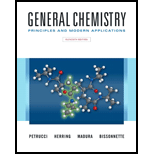
(a)
Interpretation:
The order of the reaction should be determined using given data.
Concept introduction:
The rate law/rate equation for a
(b)
Interpretation:
The rate constant of reaction should be determined using given data.
Concept introduction:
For second order reaction:
Where, k is rate constant, t is time, [A]t is concentration of A at time t and [A]o is the concentration of A at initial time that is at t = 0.
(c)
Interpretation:
Time at which [C4H6] is equal to 0.00423 M should be determined.
Concept introduction:
In a second order reaction, the rate is linearly proportional to the concentration squared of the reactant.
(d)
Interpretation:
Time at which [C4H6] is equal to 0.005 M should be determined.
Concept introduction:
In a second order reaction, the rate is linearly proportional to the concentration squared of the reactant.
Want to see the full answer?
Check out a sample textbook solution
Chapter 20 Solutions
GENERAL CHEMISTRY-MOD.MASTERINGCHEM.
- The acid-catalyzed iodination of acetone CH3COCH3(aq) + I2(aq) CH3COCH2I(aq) + HI(aq) is a common laboratory experiment used in general chemistry courses to teach the method of initial rates. The reaction is followed spectrophotometrically by the disappearance of the color of iodine in the solution. The following data (J. P. Birk and D. L Walters, Journal of Chemical Education, Vol. 69, p. 585, 1992) were collected at 23 C for this reaction. Determine the rate law for this reaction.arrow_forwardList at least four experimentally determined parameters that you, an experimenter, can define when exploring the hydrolysis of ethyl benzoate by aqueous sodium hydroxide.arrow_forwardAn enzyme kinetics experiment is carried out by adding 1.00mg of a 50.0kDa enzyme into a total volume of 50uL of buffer, and measuring the initial rates while adding increasing amounts of substrate (1 Da = 1 g/mol). The calculated Vmax from this series of experiments was 30.5mM/s. Calculate the turnover number for the enzyme.arrow_forward
- The Arrhenius parameters for the gas-phase decomposit ion of cyclobutane, C4H8(g)→ 2 C2H4(g). are log(A/s-1) = 15.6 and Ea = 261 kJ mol- 1. What is the ha lf- life of cyclobutane at (a) 20 °C, (b) 500 °C?arrow_forwardConsider the chemical reaction described by 2A(aq) ⇌ D(aq)with rate constants k1 and k-1. If the reaction is subject to a temperature jump, derive the equation for d[D]/dt in terms of a relaxation constant t.arrow_forwardThe first-order rate constant, k1, for the decomposition of ampicillin at pH 5.8 and 35?C is k1 = 2 × 10-7 sec-1. The solubility of ampicillin is 1.1 g/100 mL. If it is desired to prepare a suspension of the drug containing 2.5 g/100 mL, calculate the zero-order rate constant, k0, and the shelf-life, that is, the time in days required for the drug to decompose to 90% of its original concentration (at 35?C) in solution. Note: 100 mL = 1 deciliter = 1 dL.arrow_forward
- I monitor the reaction of Compound B with a large excess of NaOH at 298 K, and get the following results for its absorbance over time: Time (seconds) Absorbance (no units) 0 0.4555 10 0.3857 20 0.3178 30 0.2457 40 0.2011 50 0.1798 60 0.1304 On the basis of these numbers and a spreadsheet program, answer the following question: What is the most-likely order of Compound B in its reaction with NaOH? a. 0 b. 4 c. 1 d. 3 e. 2arrow_forwardCalculate the magnitude of the diffusion-controlled rate constant at 320 K for the recombination of two atoms in water, for which η = 0.89 cP. Assuming the concentration of the reacting species is 1.5 mmol dm−3 initially, how long does it take for the concentration of the atoms to fall to half that value? Assume the reaction is elementary.arrow_forwardUse the collision theory of gas-phase reactions to calculate the theoretical value of the second-order rate constant for the elementary reaction D2+ Br2 → DBr + DBr at 450 K. Take the collision cross-section as 0.30 nm2, the reduced mass as 3.930mu, and the activation energy as 200 kJ mol−1. (Assume a steric factor of 1.)arrow_forward
- An enzyme-catalyzed reaction has a Km of 1 mM and a Vmax of 4 nmole/L sec-1. The reaction velocity (nmole/L sec-1) when the substrate concentration is 0.25 mM is: A. 1.25 B. 10.0 C. 5.0 D. 0.50 E. 1.0 F. 100 G. 150 H. 55 I. 75arrow_forwardWhat is the enzymatic rate given two sets of data points: 120s, 118kPa and 90.0 s, 112 kPaarrow_forwardFor a simple reaction, S 1 P, k1 is the rate of the forward reaction and k-1 is the rate of the backwards reaction. The k1 in the absence of any enzyme was 0.01/s. The k1 in the presence of enzyme was 5,000,000/s. Calculate the rate enhancement (k1 catalyzed divided by k1 uncatalyzed) provided by the enzyme. If the equilibrium constant in the absence of enzyme is 1 x 104, what is the equilibrium constant (Keq) in the presence of enzyme?arrow_forward
 Principles of Instrumental AnalysisChemistryISBN:9781305577213Author:Douglas A. Skoog, F. James Holler, Stanley R. CrouchPublisher:Cengage Learning
Principles of Instrumental AnalysisChemistryISBN:9781305577213Author:Douglas A. Skoog, F. James Holler, Stanley R. CrouchPublisher:Cengage Learning Chemistry & Chemical ReactivityChemistryISBN:9781133949640Author:John C. Kotz, Paul M. Treichel, John Townsend, David TreichelPublisher:Cengage Learning
Chemistry & Chemical ReactivityChemistryISBN:9781133949640Author:John C. Kotz, Paul M. Treichel, John Townsend, David TreichelPublisher:Cengage Learning Chemistry & Chemical ReactivityChemistryISBN:9781337399074Author:John C. Kotz, Paul M. Treichel, John Townsend, David TreichelPublisher:Cengage Learning
Chemistry & Chemical ReactivityChemistryISBN:9781337399074Author:John C. Kotz, Paul M. Treichel, John Townsend, David TreichelPublisher:Cengage Learning Chemistry for Engineering StudentsChemistryISBN:9781337398909Author:Lawrence S. Brown, Tom HolmePublisher:Cengage Learning
Chemistry for Engineering StudentsChemistryISBN:9781337398909Author:Lawrence S. Brown, Tom HolmePublisher:Cengage Learning Physical ChemistryChemistryISBN:9781133958437Author:Ball, David W. (david Warren), BAER, TomasPublisher:Wadsworth Cengage Learning,
Physical ChemistryChemistryISBN:9781133958437Author:Ball, David W. (david Warren), BAER, TomasPublisher:Wadsworth Cengage Learning,




